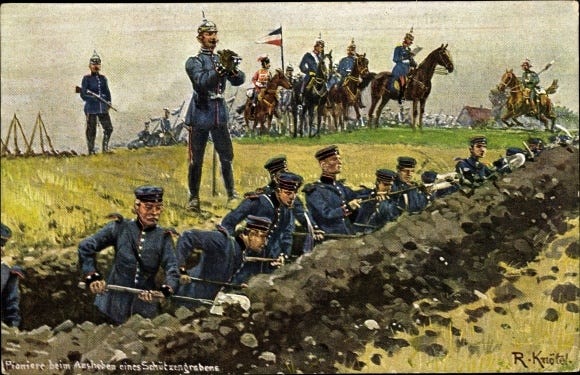The Mobilization of Pioneer Regiments
The German Army of World War I
In August of 1914, the fortress pioneer battalions of Germany’s armies mobilized in a manner similar to that of ordinary pioneer battalions. They filled vacancies in the ranks of pre-existing companies, formed reserve companies, and split into two small battalions. However, rather than going their separate ways, each pair of wartime battalions remained together as the first and second battalions of a freshly formed fortress pioneer regiment. As nine fortress pioneer battalions served in the peacetime forces of the German Empire, this process produced nine wartime fortress pioneer regiments.
The two youngest of the peacetime fortress pioneer battalions, Pionier Bataillon 29 and Pionier Bataillon 30, which had been established in July of 1913, lacked the trained reservists needed to form reserve companies. Thus, the fortress pioneer regiments formed by those peacetime units went to war with four companies apiece.
Six of the nine fortress pioneer regiments reported, at a rate of two regiments per army, to the three field armies which expected to encounter particularly strong fortresses during the first few weeks of the war. The three remaining fortress pioneer regiments were allocated, at a rate of one regiment per army, to other armies in the West. (The Seventh and Eighth Armies, charged , respectively, with the defense of Alsace and operations in East Prussia, got no fortress pioneer regiments at all.)
Sources: Information about the assignment of pioneer regiments to field armies comes from the organizational appendices of the first two volumes of the German official history, Der Weltkrieg 1914-1918, and the data provided by Eike Mohr, Heeres-und-Truppengeschichte des Deutschen Reiches und seiner Länder 1806 bis 1918, (Osnabrück: Biblioverlag, 1989), pages 575-577
Note: The list of fortress pioneer regiments omits Pionier Regiment 31. Assembled from two ordinary pioneer battalions (II./28 Bataillon and II./Garde Pionier Bataillon) and an improvised regimental headquarters, it lacked the siege equipment that was provided to regularly constituted fortress pioneer regiments. On 11 September 1914, after spending five weeks in Schleswig-Holstein and the city of Liège, it joined the Seventh Army. Siegfried Held Das Königlich Preußische Garde-Pionier-Bataillon und seine Kriegsverbände 1914/18 (Berlin: Carl F. Berg, 1932), Volume I, pages 109-113
.





What skill sets for fortress pioneers?
Regarding the reserve companies.
Do you know if both were assigned to one battalion (like the field engineers) or if they were split amongst the two battalions?